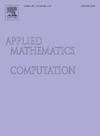Optimizing symbol visibility through displacement
IF 3.5
2区 数学
Q1 MATHEMATICS, APPLIED
引用次数: 0
Abstract
In information visualization, the position of symbols often encodes associated data values. When visualizing data elements with both a numerical and a categorical dimension, positioning in the categorical axis admits some flexibility. This flexibility can be exploited to reduce symbol overlap, and thereby increase legibility. In this paper, we initialize the algorithmic study of optimizing symbol legibility via a limited displacement of the symbols.
Specifically, we consider closed unit square symbols that need to be placed at specified y-coordinates. We optimize the drawing order of the symbols as well as their x-displacement, constrained within a rectangular container, to maximize the minimum visible perimeter over all squares. If the container has width and height at most 2, there is a point that stabs all squares. In this case, we prove that a staircase layout is arbitrarily close to optimality and can be computed in time. If the width is at most 2, there is a vertical line that stabs all squares, and in this case, we design a 2-approximation algorithm (assuming fixed container height) that runs in time. As it turns out that a minimum visible perimeter of 2 is always achievable with a generic construction, we measure this approximation with respect to the visible perimeter exceeding 2. We show that, despite its simplicity, the algorithm gives asymptotically optimal results for certain instances.
通过置换优化符号可见性
在信息可视化中,符号的位置通常编码相关的数据值。在同时显示数字维度和分类维度的数据元素时,在分类轴上的定位具有一定的灵活性。这种灵活性可以用来减少符号重叠,从而提高可读性。在本文中,我们初步研究了通过有限的符号位移来优化符号易读性的算法。具体来说,我们考虑需要放置在指定y坐标上的封闭单位正方形符号。我们优化了符号的绘制顺序以及它们的x-位移,约束在一个矩形容器内,以最大化所有正方形的最小可见周长。如果容器的宽度和高度最多为2,则存在一个刺穿所有正方形的点。在这种情况下,我们证明了阶梯布局是任意接近最优的,并且可以在O(nlog) n时间内计算出来。如果宽度最多为2,则有一条垂直线刺穿所有的正方形,在这种情况下,我们设计了一个2逼近算法(假设容器高度固定),运行时间为O(nlog (n))。事实证明,对于一般结构,最小可视周长为2总是可以实现的,我们对可视周长超过2的近似进行测量。我们证明,尽管它很简单,但算法对某些实例给出了渐近最优结果。
本文章由计算机程序翻译,如有差异,请以英文原文为准。
求助全文
约1分钟内获得全文
求助全文
来源期刊
CiteScore
7.90
自引率
10.00%
发文量
755
审稿时长
36 days
期刊介绍:
Applied Mathematics and Computation addresses work at the interface between applied mathematics, numerical computation, and applications of systems – oriented ideas to the physical, biological, social, and behavioral sciences, and emphasizes papers of a computational nature focusing on new algorithms, their analysis and numerical results.
In addition to presenting research papers, Applied Mathematics and Computation publishes review articles and single–topics issues.

 求助内容:
求助内容: 应助结果提醒方式:
应助结果提醒方式:


